
Life is full of surprises. Take me for example, I'm not as young as I look. And that's all down to the restorative elixir made from Nature's wonder: turmeric. Yes, that's right, for only a few pence a day, you too can look and feel like me. And you will have the guaranteed extra benefit of living forever.*
Try as I might these days to shop and eat food from sources I know and trust, it's not always possible if I want to continue with the occasional exoticism. We have been trading spices for years as a nation (not always necessarily in a morally legitimate way) so I accept that my cupboards are full of fragrant wonders of the world I thoughtlessly spice up our meals with.
The turmeric in this drink came from Peru and I have no idea of what the lives of the farmers and workers is like. The almond milk supposedly came from organic small growers and co-operatives, but we all know that a lot of almond farming is on environmentally shaky ground and the cost of growing is huge.
The pepper came from Telicherry, Kerala, meant to be the finest pepper in the world. As I stir it into the drink, savouring its fruity aroma, what's the picker doing after a day's work? And the saffron, cardamon and coconut oil that goes into it too? Could I not just be happy with a fresh mint tea, made from the herbs growing in my garden? But then I think if there was no demand for all of this, there would be no point in growing it and no economic benefit. Is a pathetic wage really an economic benefit at all?
I love this drink though. It's comforting, healthy, tasty and nourishing. But as with everything we ravishingly consume it's worth stopping to think a little about where it comes from and the people who have been involved in its journey. From the earth to the farmers who grew it; the pickers and packers; the delivery drivers who collect and transport it; the shipyard workers and the ship's crew; the distribution workers here and the people you hand your money over to before you bring it home. All for a moment's pleasure and the guarantee of eternal life.**
*not a guaranteed benefit.
**not a guarantee.
Method
I make a paste from about five tablespoons of turmeric powder (dried is best for this, it is more concentrated so you get more of the curcumin) and add a fair amount of water until it's the texture of houmous.
This is all done in a small pan on a gentle heat, so when I add a tablespoon of coconut oil, it melts easily in and is quickly absorbed.
A good twist of pepper, some ground cardamon (about a teaspoon's-worth), a pinch of chilli flakes or cayenne pepper and sometimes a touch of ground cloves go in.
Finally, a pinch of saffron if I'm feeling the urge, maybe some ground ginger or cinnamon and then I transfer it to a glass jar, kept in the fridge to use over the course of the week.
To make it up, put a heaped tablespoon of the paste in a small milk pan and top up with a tumbler-full of almond milk. You can, if you prefer use cow's milk, coconut milk, soy milk, rice milk, whatever.
Stir well and serve warm.

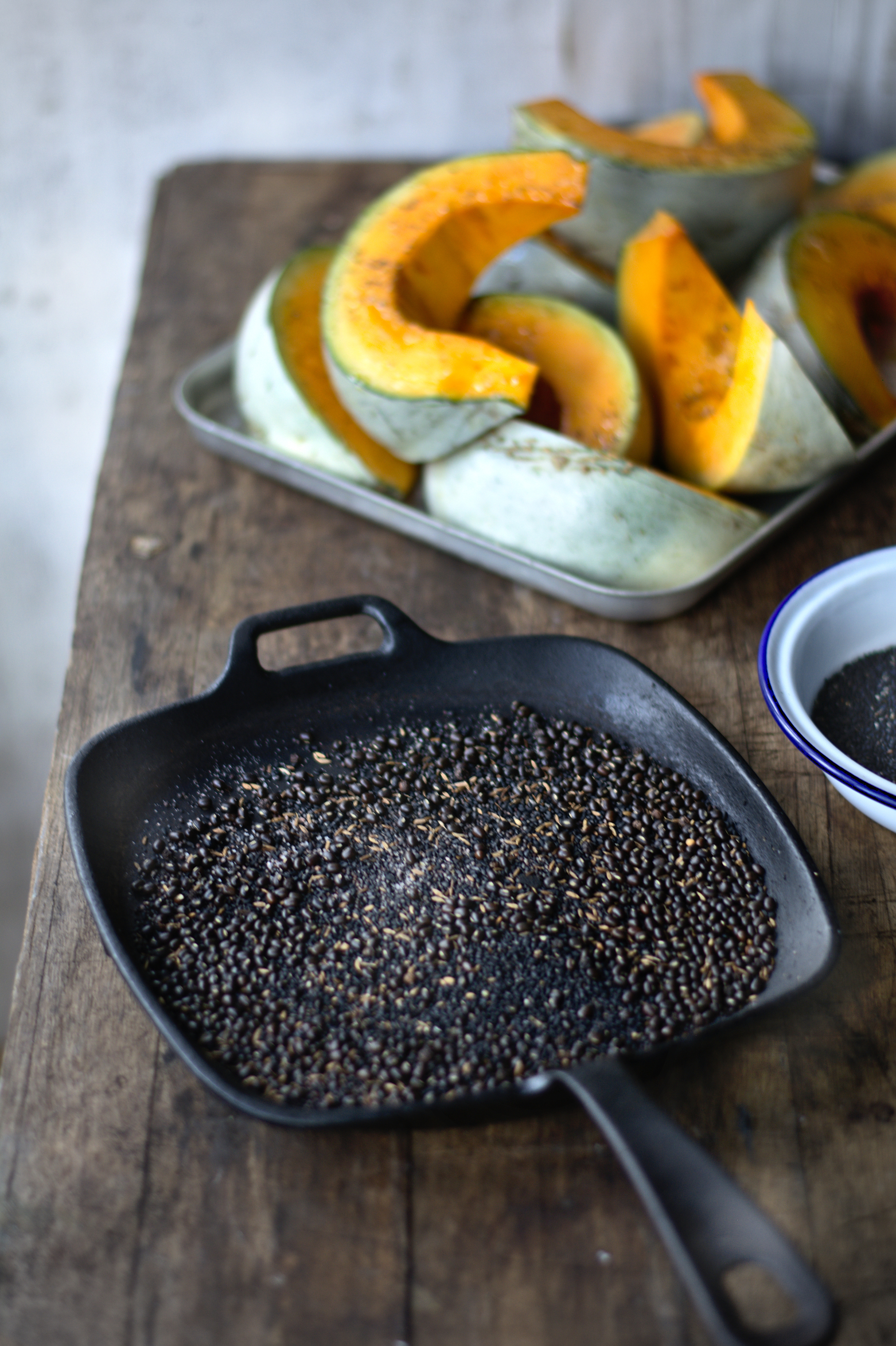


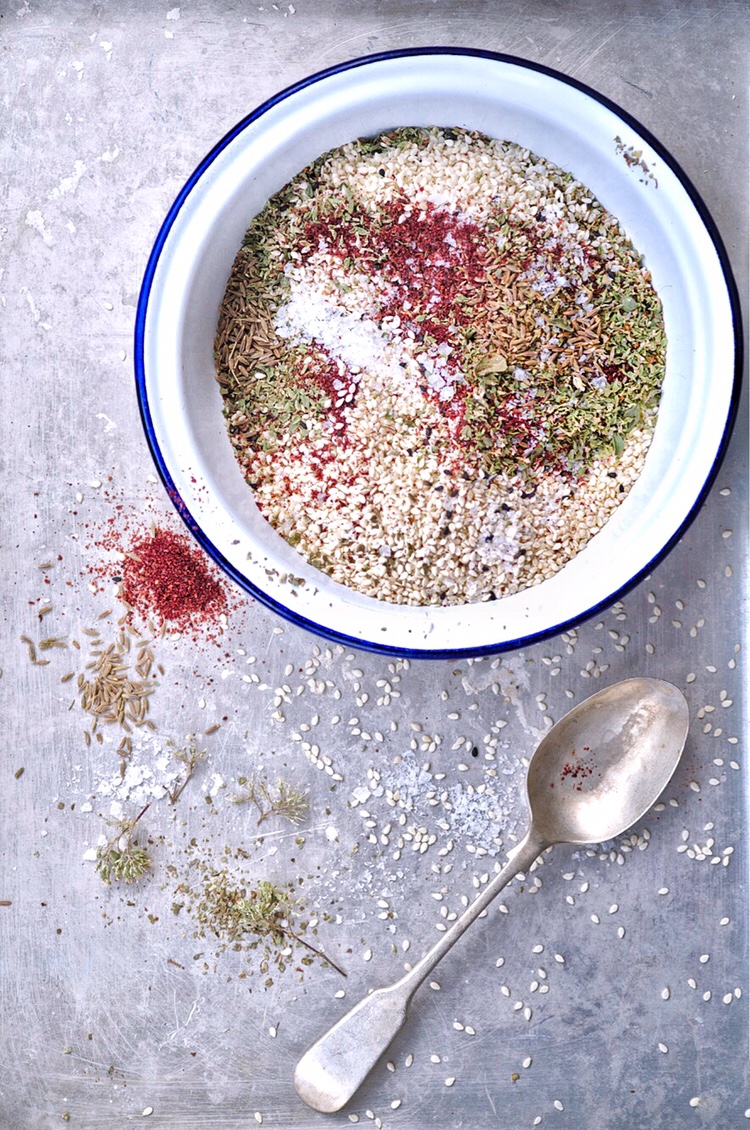 With this incessant sunshine the pace of life changes. I feel all we are good for is to flop down somewhere warm, the only occasional movement being the lifting of a cold glass of lime, mint and ginger soda to our lips, and the only words spoken are the ones to our punkah wallah to increase the fanning speed.And with that in mind, our meals have been made with the minimum of time and effort this week. But they have by no means suffered in flavour. We've had chicken thighs, poached and shredded and tossed in a peanut butter, sesame oil and soy sauce along the lines of bang bang chicken. The cucumber and spring onion a refreshing breeze through the richness as we suffered the tension of a penalty shootout.One evening I slowly roasted tomatoes with garlic and harissa in the cocotte in plenty of olive oil then stirred in cooked chickpeas and spinach and served that with some five minute lamb kebabs laced with cardamom and cumin. This cocotte method is fantastic, something you can do in the background and once cooled you stuff the tomatoes and their juices into kilner jars and keep them in the fridge to use during the week. There is no need to buy tinned tomatoes if you do this and the flavour and intensity is out of this world.And last night we had kasha, (toasted buckwheat) simmered in double the amount of water and mixed through with sautéed onions, chestnut mushrooms a good lump of butter and a healthy squeeze of lemon juice. On top of this I added salmon fillets I'd seasoned and then rolled around in za'tar. A quick flash in the frying pan and supper was ready.So today's recipe is for this versatile spice mix. You can, of course, buy it ready made, but if this way, being homemade, it's in your hands how it tastes. You can take charge of your own flavours as you see fit.Trying to give a definitive ingredient list for a spice blend is the culinary equivalent of describing music. Just as there is not one dahl recipe, when you are mixing, blending and tweaking spices around a theme -- in this case a Middle Eastern sesame seeds one -- the variations are infinite and based on personal preference. Just bear in mind that the sesame seeds should take up roughly half of the total mixture. Whether or not you toast them is up to you. I don't because I find the flavour becomes too strongly nutty, and there is enough going on already. You can replace the marjoram with dried winter savoury if you like and add a pinch of black sesame seeds as I do.Give it a little bash in the pestle and mortar to release some of the cumin oil and store in a jar to use on grilled lemon chicken breasts or to add to lamb cutlets before chargrilling and serving with aubergine and chick peas. You could also sprinkle it over grilled courgettes or roast strips of red pepper too. It can go on flatbreads before grilled or be mixed with olive oil and used as a dip for after.IngredientsSesame seedsGround sumacDried oreganoDried marjoramCumin seedsSaltMethodHalf fill a bowl with sesame seeds then divide the remaining space with a pinch of black sesame seeds if you have any, sumac, dried oregano, dried marjoram, cumin seeds (you can toast these first if you like, try it and see which you prefer) and a pinch of salt.Bash it about a little with a pestle and it's ready.
With this incessant sunshine the pace of life changes. I feel all we are good for is to flop down somewhere warm, the only occasional movement being the lifting of a cold glass of lime, mint and ginger soda to our lips, and the only words spoken are the ones to our punkah wallah to increase the fanning speed.And with that in mind, our meals have been made with the minimum of time and effort this week. But they have by no means suffered in flavour. We've had chicken thighs, poached and shredded and tossed in a peanut butter, sesame oil and soy sauce along the lines of bang bang chicken. The cucumber and spring onion a refreshing breeze through the richness as we suffered the tension of a penalty shootout.One evening I slowly roasted tomatoes with garlic and harissa in the cocotte in plenty of olive oil then stirred in cooked chickpeas and spinach and served that with some five minute lamb kebabs laced with cardamom and cumin. This cocotte method is fantastic, something you can do in the background and once cooled you stuff the tomatoes and their juices into kilner jars and keep them in the fridge to use during the week. There is no need to buy tinned tomatoes if you do this and the flavour and intensity is out of this world.And last night we had kasha, (toasted buckwheat) simmered in double the amount of water and mixed through with sautéed onions, chestnut mushrooms a good lump of butter and a healthy squeeze of lemon juice. On top of this I added salmon fillets I'd seasoned and then rolled around in za'tar. A quick flash in the frying pan and supper was ready.So today's recipe is for this versatile spice mix. You can, of course, buy it ready made, but if this way, being homemade, it's in your hands how it tastes. You can take charge of your own flavours as you see fit.Trying to give a definitive ingredient list for a spice blend is the culinary equivalent of describing music. Just as there is not one dahl recipe, when you are mixing, blending and tweaking spices around a theme -- in this case a Middle Eastern sesame seeds one -- the variations are infinite and based on personal preference. Just bear in mind that the sesame seeds should take up roughly half of the total mixture. Whether or not you toast them is up to you. I don't because I find the flavour becomes too strongly nutty, and there is enough going on already. You can replace the marjoram with dried winter savoury if you like and add a pinch of black sesame seeds as I do.Give it a little bash in the pestle and mortar to release some of the cumin oil and store in a jar to use on grilled lemon chicken breasts or to add to lamb cutlets before chargrilling and serving with aubergine and chick peas. You could also sprinkle it over grilled courgettes or roast strips of red pepper too. It can go on flatbreads before grilled or be mixed with olive oil and used as a dip for after.IngredientsSesame seedsGround sumacDried oreganoDried marjoramCumin seedsSaltMethodHalf fill a bowl with sesame seeds then divide the remaining space with a pinch of black sesame seeds if you have any, sumac, dried oregano, dried marjoram, cumin seeds (you can toast these first if you like, try it and see which you prefer) and a pinch of salt.Bash it about a little with a pestle and it's ready.
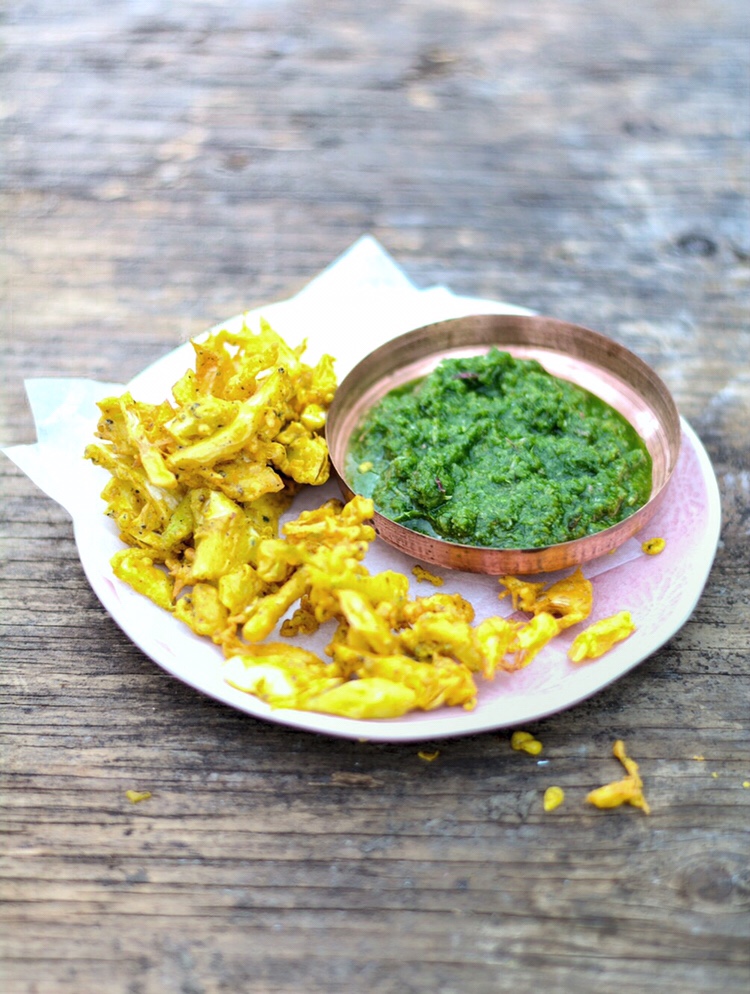 I had just locked the garage door when I noticed the coriander had bolted. And what with the rather sad looking fennel in the fridge I realised I needed to turn my neglect into something positive. The crisp crunch of anything deep-fried is a textural pleasure and as naughty as it feels, it doesn't necessarily mean it's unhealthy. Unless of course we are talking Mars Bars or perhaps a saveloy, made from who knows what. Vegetable tempura, crisp on the outside and delicate within, salt and pepper prawns, elderflowers, even. If you keep it hot and quick and don't do it every day, things will be ok.So to rescue the fennel I used it in place of onions in a bhaji. And I plucked what coriander leaves and stems I could save and blitzed them with green chillies and garlic to make a fiery green chutney to dip the zesty, spiced fennel into.These are also good with a herby yoghurt dip if there are children or chilli scaredy-cats lurking around the place. If you don't have some of the spices, which I admit can be a little tricky to get hold of (unless you live near Tooting) feel free to leave them out. For an even speedier version, just make a batter with garam masala or curry powder, it will still be delicious.IngredientsFor the batter:5 cloves1tsp fennel seeds1tsp coriander seeds1tsp black mustard seeds1tsp amchoor (mango) powder1/2tsp nigella seeds1/2tsp tukmuria (basil) seeds1tsp cumin seeds1/2tsp cardamon seeds1tsp turmeric powderSalt and pepper to season100g Chickpea flour (gram flour)Enough water to make a batter as thick as double cream.1 fennel bulb, slicedFor the chutney:A large handful of coriander leaves and stemsA few green chilliesA clove of garlicA splash of cider vinegarA pinch of saltMethodGrind the spices to a powder and mix with the chickpea flour. Stir in the water to make a batter.Meanwhile, blitz the chutney ingredients together in a blender and set aside.Heat two litres of rapeseed oil in a deep-fat fryer to 180c or half fill a heavy-based saucepan with the oil and heat. It's ready when you drop a little batter in it and it immediately sizzles and starts to colour.Dip the fennel in the batter and fry in small batches. Drain on kitchen paper and serve hot with the chutney.This weekWatchedBirdman with Michael Keaton. Excellently acted and directed, I really felt we were part of the theatre. A few bits of it left me a little cold and annoyed, although perhaps that's because we were watching it outside as part of the
I had just locked the garage door when I noticed the coriander had bolted. And what with the rather sad looking fennel in the fridge I realised I needed to turn my neglect into something positive. The crisp crunch of anything deep-fried is a textural pleasure and as naughty as it feels, it doesn't necessarily mean it's unhealthy. Unless of course we are talking Mars Bars or perhaps a saveloy, made from who knows what. Vegetable tempura, crisp on the outside and delicate within, salt and pepper prawns, elderflowers, even. If you keep it hot and quick and don't do it every day, things will be ok.So to rescue the fennel I used it in place of onions in a bhaji. And I plucked what coriander leaves and stems I could save and blitzed them with green chillies and garlic to make a fiery green chutney to dip the zesty, spiced fennel into.These are also good with a herby yoghurt dip if there are children or chilli scaredy-cats lurking around the place. If you don't have some of the spices, which I admit can be a little tricky to get hold of (unless you live near Tooting) feel free to leave them out. For an even speedier version, just make a batter with garam masala or curry powder, it will still be delicious.IngredientsFor the batter:5 cloves1tsp fennel seeds1tsp coriander seeds1tsp black mustard seeds1tsp amchoor (mango) powder1/2tsp nigella seeds1/2tsp tukmuria (basil) seeds1tsp cumin seeds1/2tsp cardamon seeds1tsp turmeric powderSalt and pepper to season100g Chickpea flour (gram flour)Enough water to make a batter as thick as double cream.1 fennel bulb, slicedFor the chutney:A large handful of coriander leaves and stemsA few green chilliesA clove of garlicA splash of cider vinegarA pinch of saltMethodGrind the spices to a powder and mix with the chickpea flour. Stir in the water to make a batter.Meanwhile, blitz the chutney ingredients together in a blender and set aside.Heat two litres of rapeseed oil in a deep-fat fryer to 180c or half fill a heavy-based saucepan with the oil and heat. It's ready when you drop a little batter in it and it immediately sizzles and starts to colour.Dip the fennel in the batter and fry in small batches. Drain on kitchen paper and serve hot with the chutney.This weekWatchedBirdman with Michael Keaton. Excellently acted and directed, I really felt we were part of the theatre. A few bits of it left me a little cold and annoyed, although perhaps that's because we were watching it outside as part of the 

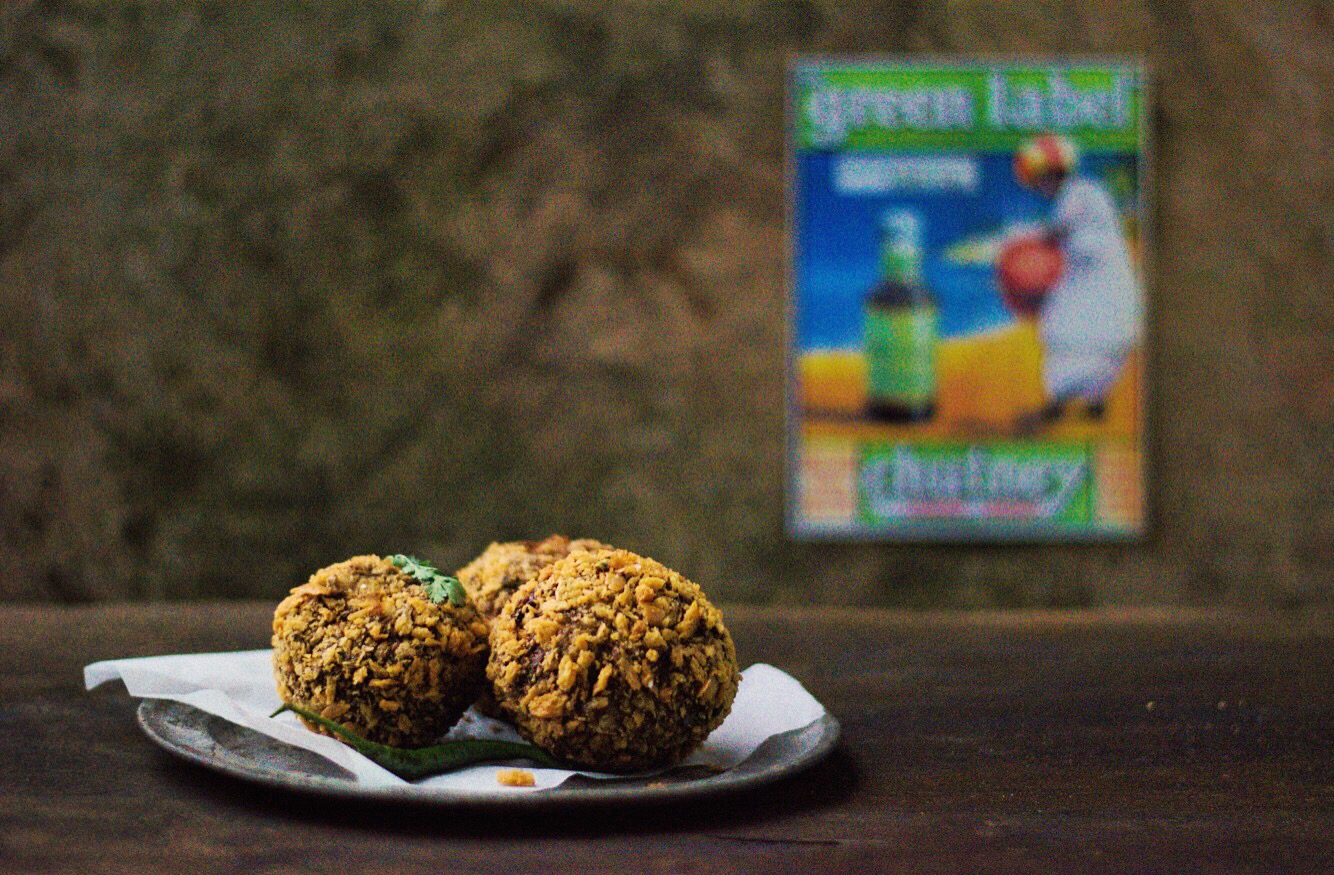
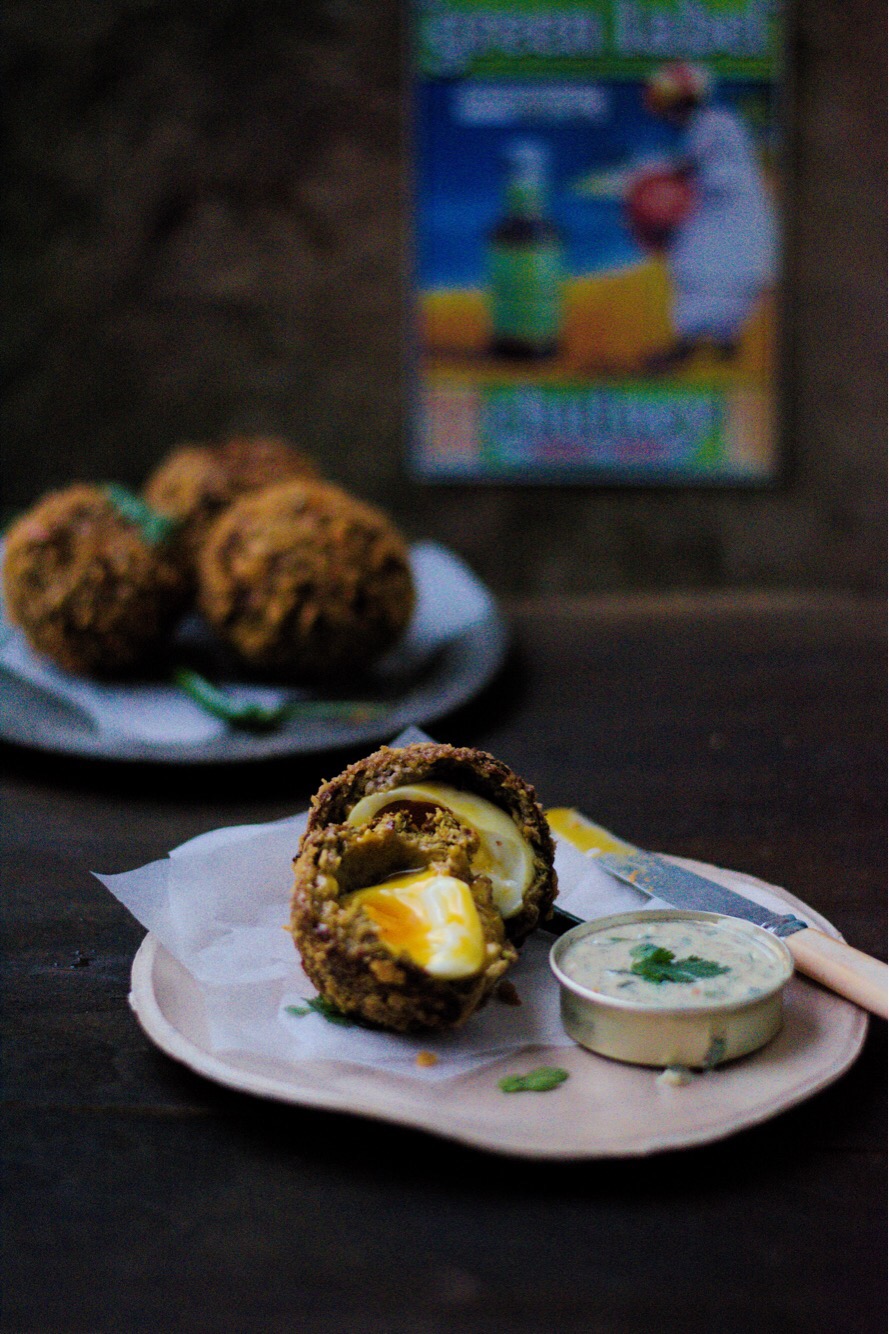 The petrol station. Where food goes to die. This is why people think badly of Scotch eggs, although, thankfully there has been a little positive renaissance recently of these picnic staples, and done well, they are delicious. There was even a recent trend for 'artisan scotch eggs' in the edgier areas of London. Although why you'd want an artisan to make your lunch rather than a cook is beyond me. It would probably be full of wood shavings and metal filings. And no doubt beard hair.There is much debate about the origin of this dish. I wonder if 'scotching' an egg means keeping it alive but rendering it harmless inside a case. Shakespeare says in Macbeth 'We have scotch'd the snake, not kill'd it’ (see, Mrs. Hutchings, I was paying attention at the back). But whatever the origin of the term, it doesn't seem to be used for any other dishes. And whatever the method or serving, egg wrapped in meat cannot fail to be a good thing. Unless you're vegan. Or vegetarian.Allegedly invented in the 18th century at Fortnum and Masons, the dish pops up all over the place if you look carefully behind the cushions. The one that excited me most of all was from Lucknow, in India. Their version is served in a rich, spicy gravy but here I've taken those flavours and added them to the meat itself then serve it with a yoghurt dipping sauce. A kind of Scotch egg curry. Bloody hell. And as with many British meals, our Empire travels, subjugation and plundering has given us a wide variety of dishes full of spice and exotic backgrounds. Every cloud and all that...Ingredients500g lamb minceA few tablespoons of paste made from onion, green chilli, garlic and ginger2tsp ground turmeric1tbsp ground cumin1tbsp chilli powder1tbsp ground cumin2tsp dried mint2tsp ground fenugreekSalt and pepper4 eggs, boiled for five and a half minutes then quickly cooled (I boiled mine for four minutes for a runny and explosive yolk filling, but you may want it firmer)Breadcrumbs (I used panko and crushed them a little) mixed with 1tbsp garam masala.For the dip:Natural yoghurtCoriander leaves, choppedMint leaves, choppedToasted flaked almonds1/2tsp grated garlic1/2tsp grated gingerPinch of ground cinnamon, ground cardamom and caraway seedsMethodMix the meat and spices together and wrap each egg in a layer of the mixture, making sure the whole egg is sealed. Do this gently, it's easy to squash them.Put in the fridge for an hour to chill and firm then roll each one in the breadcrumbs, pressing them into the meat.If you have a deep-fryer, this is what it was born for. If not, carefully cook them in oil in a deep and heavy pan, only half-filling it to avoid accidents and over spill.Heat the oil to 180c and cook the eggs, a couple at a time until golden brown all over. This will take about four to five minutes.Drain on kitchen paper and leave to cool a little before serving with the dip, extra green chillies and coriander leaves.
The petrol station. Where food goes to die. This is why people think badly of Scotch eggs, although, thankfully there has been a little positive renaissance recently of these picnic staples, and done well, they are delicious. There was even a recent trend for 'artisan scotch eggs' in the edgier areas of London. Although why you'd want an artisan to make your lunch rather than a cook is beyond me. It would probably be full of wood shavings and metal filings. And no doubt beard hair.There is much debate about the origin of this dish. I wonder if 'scotching' an egg means keeping it alive but rendering it harmless inside a case. Shakespeare says in Macbeth 'We have scotch'd the snake, not kill'd it’ (see, Mrs. Hutchings, I was paying attention at the back). But whatever the origin of the term, it doesn't seem to be used for any other dishes. And whatever the method or serving, egg wrapped in meat cannot fail to be a good thing. Unless you're vegan. Or vegetarian.Allegedly invented in the 18th century at Fortnum and Masons, the dish pops up all over the place if you look carefully behind the cushions. The one that excited me most of all was from Lucknow, in India. Their version is served in a rich, spicy gravy but here I've taken those flavours and added them to the meat itself then serve it with a yoghurt dipping sauce. A kind of Scotch egg curry. Bloody hell. And as with many British meals, our Empire travels, subjugation and plundering has given us a wide variety of dishes full of spice and exotic backgrounds. Every cloud and all that...Ingredients500g lamb minceA few tablespoons of paste made from onion, green chilli, garlic and ginger2tsp ground turmeric1tbsp ground cumin1tbsp chilli powder1tbsp ground cumin2tsp dried mint2tsp ground fenugreekSalt and pepper4 eggs, boiled for five and a half minutes then quickly cooled (I boiled mine for four minutes for a runny and explosive yolk filling, but you may want it firmer)Breadcrumbs (I used panko and crushed them a little) mixed with 1tbsp garam masala.For the dip:Natural yoghurtCoriander leaves, choppedMint leaves, choppedToasted flaked almonds1/2tsp grated garlic1/2tsp grated gingerPinch of ground cinnamon, ground cardamom and caraway seedsMethodMix the meat and spices together and wrap each egg in a layer of the mixture, making sure the whole egg is sealed. Do this gently, it's easy to squash them.Put in the fridge for an hour to chill and firm then roll each one in the breadcrumbs, pressing them into the meat.If you have a deep-fryer, this is what it was born for. If not, carefully cook them in oil in a deep and heavy pan, only half-filling it to avoid accidents and over spill.Heat the oil to 180c and cook the eggs, a couple at a time until golden brown all over. This will take about four to five minutes.Drain on kitchen paper and leave to cool a little before serving with the dip, extra green chillies and coriander leaves.
 Potato has to be one of life's great comfort foods. And while I rail about the result versus the time and planning taken to bake a jacket potato to golden crunchy skin and a fluffy inside, there's no denying that slathered in butter, salt, pepper and melting Cheddar cheese, there's not much to rival it in the crawling under the duvet of food stakes.There are so many things you can do with the potato as we know, but here, because it's such a great absorber of flavour -think of the roast potatoes sucking up the juices from the meat at the end of Sunday lunch- I've used it in a curry. This goes a little beyond the quick spinach and potato saag aloo in that the spice mix is a lot more involved, it's a little saucier and the addition of tomatoes gives it a tangy and sweet richness.It's a dish I happily have on its own, but equally will go fantastically well as a side dish for a slow-roast spicy marinated lamb dish if you want a more exciting Sunday. It also makes a great dosa filling, and the chilli in this will certainly make for a more exciting breakfast. Perhaps a little too exciting, but it will certainly wake you up. And possibly ruin the day if you feed it to the children instead of egg on toast or porridge.Make the spice mix in advance and keep it in an airtight jar, then it's a matter of moments to put the dish together and leave it to simmer away for about 25 minutes to cook and thicken.IngredientsFor the spice mix:I used a combination of the following in fairly equal quantities, but you can adjust if you prefer it to have more or less heat, more aniseedy flavour and so on.SaltChilli powderGround turmericBlack mustard seedMango powderCardamonClovesFenugreek seedCuminCoriander seedFennel seedNigella seedCitric acidGarlic powderBlack pepperFor the curry:1kg Maris Piper potatoes, cut into smallish chunks150g cherry tomatoes4tbsp spice mixA few handfuls of spinachFresh coriander and sliced green chilli to serveMethodBlitz the ingredients for the spice mix into a powder. After you've blitzed it all, add some whole coriander, cumin, fennel and nigella seeds which give the finished dish an extra element of flavour.Put the potatoes, four tablespoons of spice mix and tomatoes in a large saucepan and just cover with water. Bring to the boil and cook until the potatoes are soft and the water has reduced by about half.Mash some of the potato into the liquid to thicken it and add the spinach.Stir well until the spinach has wilted, check the seasoning, add some coriander leaves and green chilli and serve. Easy.
Potato has to be one of life's great comfort foods. And while I rail about the result versus the time and planning taken to bake a jacket potato to golden crunchy skin and a fluffy inside, there's no denying that slathered in butter, salt, pepper and melting Cheddar cheese, there's not much to rival it in the crawling under the duvet of food stakes.There are so many things you can do with the potato as we know, but here, because it's such a great absorber of flavour -think of the roast potatoes sucking up the juices from the meat at the end of Sunday lunch- I've used it in a curry. This goes a little beyond the quick spinach and potato saag aloo in that the spice mix is a lot more involved, it's a little saucier and the addition of tomatoes gives it a tangy and sweet richness.It's a dish I happily have on its own, but equally will go fantastically well as a side dish for a slow-roast spicy marinated lamb dish if you want a more exciting Sunday. It also makes a great dosa filling, and the chilli in this will certainly make for a more exciting breakfast. Perhaps a little too exciting, but it will certainly wake you up. And possibly ruin the day if you feed it to the children instead of egg on toast or porridge.Make the spice mix in advance and keep it in an airtight jar, then it's a matter of moments to put the dish together and leave it to simmer away for about 25 minutes to cook and thicken.IngredientsFor the spice mix:I used a combination of the following in fairly equal quantities, but you can adjust if you prefer it to have more or less heat, more aniseedy flavour and so on.SaltChilli powderGround turmericBlack mustard seedMango powderCardamonClovesFenugreek seedCuminCoriander seedFennel seedNigella seedCitric acidGarlic powderBlack pepperFor the curry:1kg Maris Piper potatoes, cut into smallish chunks150g cherry tomatoes4tbsp spice mixA few handfuls of spinachFresh coriander and sliced green chilli to serveMethodBlitz the ingredients for the spice mix into a powder. After you've blitzed it all, add some whole coriander, cumin, fennel and nigella seeds which give the finished dish an extra element of flavour.Put the potatoes, four tablespoons of spice mix and tomatoes in a large saucepan and just cover with water. Bring to the boil and cook until the potatoes are soft and the water has reduced by about half.Mash some of the potato into the liquid to thicken it and add the spinach.Stir well until the spinach has wilted, check the seasoning, add some coriander leaves and green chilli and serve. Easy.


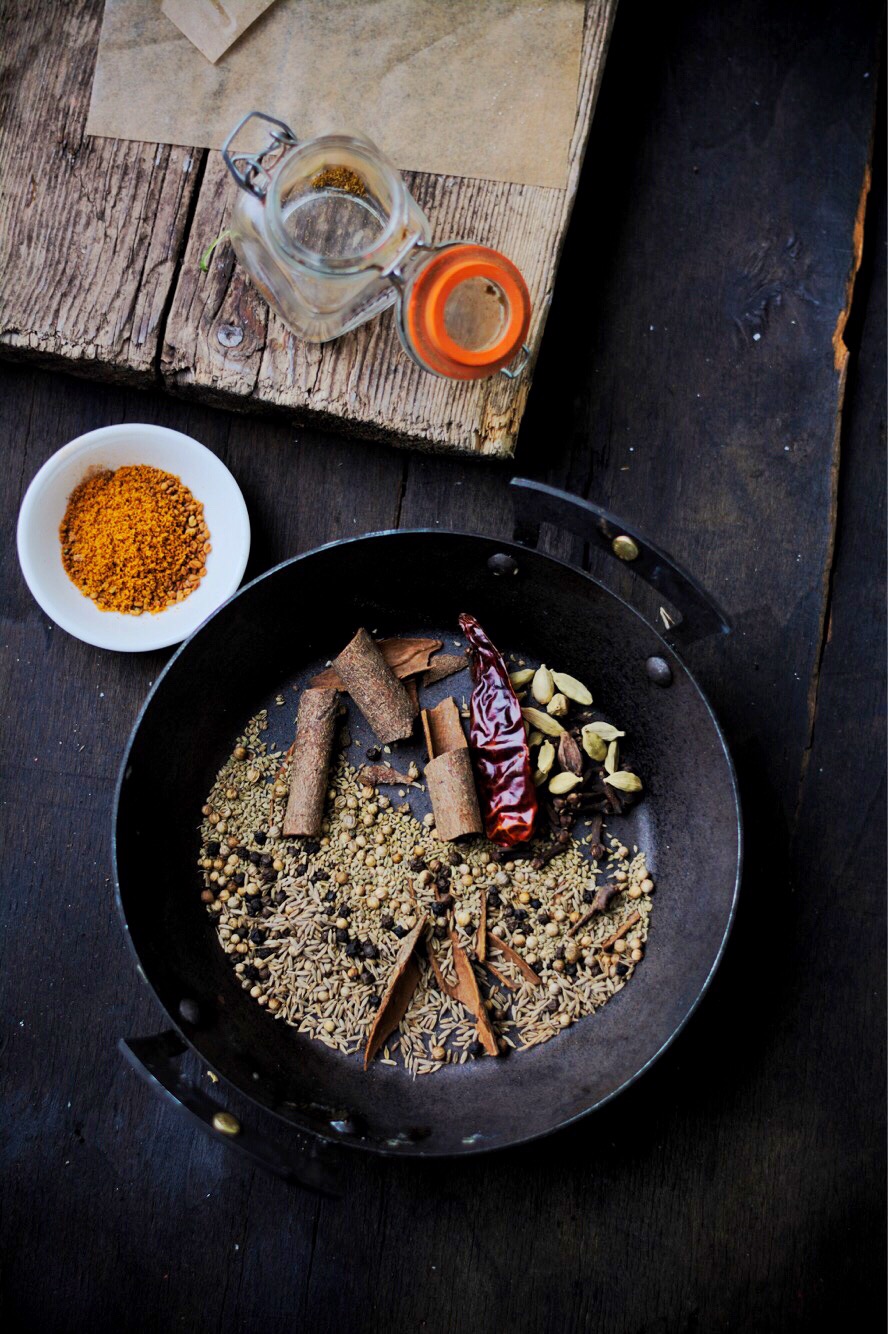

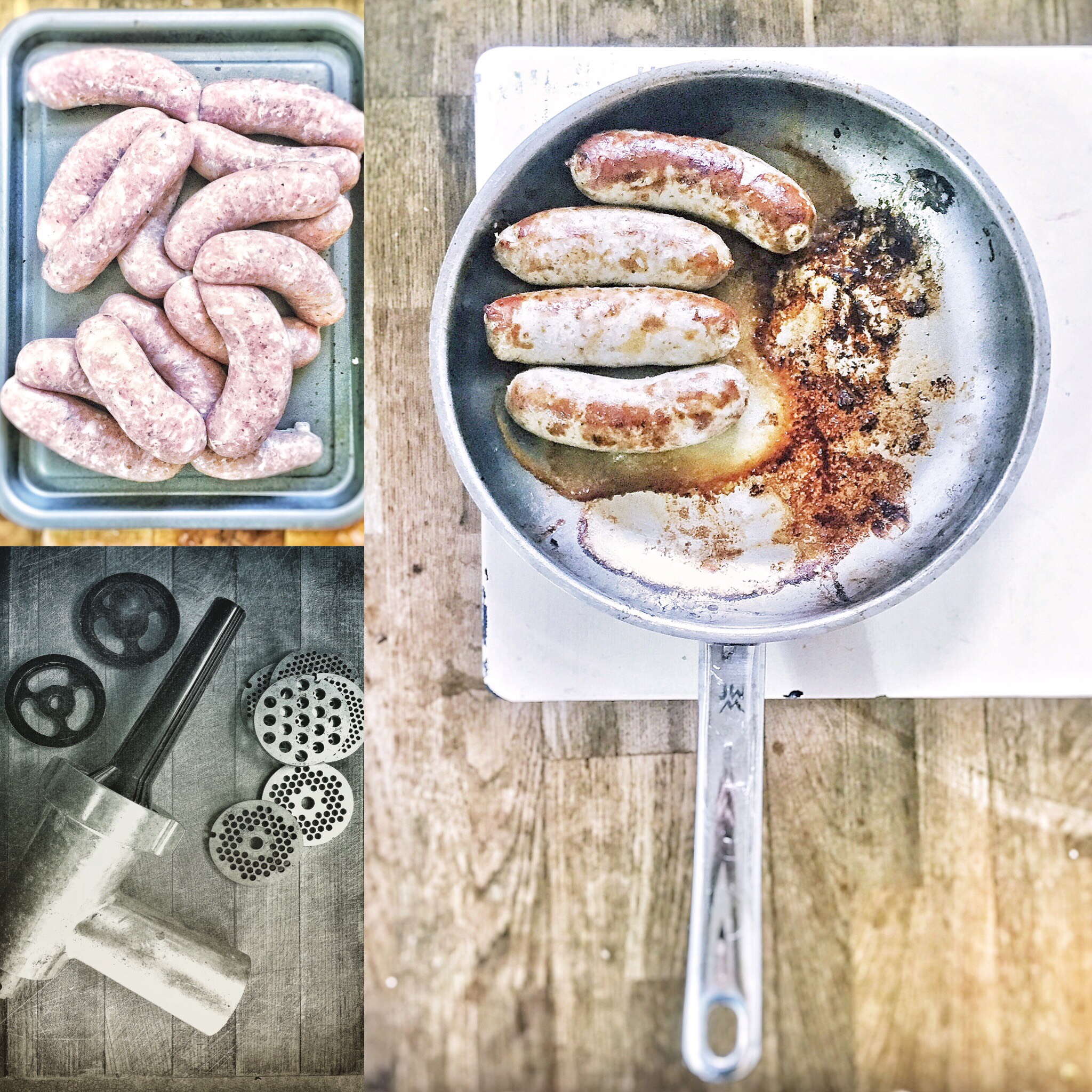 Tomorrow the children go back to school after six years off for Easter. I think we're all looking forward to it. It has been good having them around, though, and we've had some fun in the kitchen. Notably making these sausages.Normally, you'd put breadcrumbs in British-style sausages, that's one of the reasons they're not as dense as the meatier Italian ones, or, my favourite, merguez, which I shall be making soon. So to make these wheat-free, I used milled flax seed instead, which helped bind the mixture as well as give a little extra texture.They're quick to make and you can buy the casings from your butcher or online. Making them yourself means there are no additives in them, and you can vary the spicing and herbs as you like, as well as the thickness and length. We got 18 large ones out of this, so quite a few went in the freezer.You can ask your butcher to mince the meat for you if you don't have a mincer at home, and you will need a sausage maker, you can also get these cheaply online. You can, however, skip the casings and roll them by hand into sausage shapes if you want. I'd highly recommend a machine though, not least for the opportunity to add a touch of 'Carry-On' to the kitchen. It's not possible to put the casing on the nozzle without thinking about GCSE biology with Mr. Johnson.Experiment with garlic, herb and red wine or mixed spices. Leek and apple perhaps, and paprika and onion. We'll not be buying sausages any more.Ingredients800g pork mince or pork shoulder800g pork belly1tbsp ground ginger1tbsp ground five-spice1tbsp ground nutmeg1tbsp dried oregano1tbsp dried tarragon1tbsp dried thyme2tbsp flax seedPepperLoads of salt150ml cold water2m hog casing sausage skinMethodMince the meat and mix in the rest of the ingredients.Fry a little of the mixture to test the seasoning and adjust as needed.Try not to snigger as you roll the casing on to the nozzle.Turn the machine on and slowly feed the mixture through until it starts to fill the casing. Gradually let it fill until you reach the desired size then twist to seal and carry on. Twist the opposite way on the next one and repeat until finished.You can cook them straight away, (I tend to grill them) but it's better to let them dry a little, uncovered, in the fridge for a day.Wrap well and freeze what you don't need immediately.
Tomorrow the children go back to school after six years off for Easter. I think we're all looking forward to it. It has been good having them around, though, and we've had some fun in the kitchen. Notably making these sausages.Normally, you'd put breadcrumbs in British-style sausages, that's one of the reasons they're not as dense as the meatier Italian ones, or, my favourite, merguez, which I shall be making soon. So to make these wheat-free, I used milled flax seed instead, which helped bind the mixture as well as give a little extra texture.They're quick to make and you can buy the casings from your butcher or online. Making them yourself means there are no additives in them, and you can vary the spicing and herbs as you like, as well as the thickness and length. We got 18 large ones out of this, so quite a few went in the freezer.You can ask your butcher to mince the meat for you if you don't have a mincer at home, and you will need a sausage maker, you can also get these cheaply online. You can, however, skip the casings and roll them by hand into sausage shapes if you want. I'd highly recommend a machine though, not least for the opportunity to add a touch of 'Carry-On' to the kitchen. It's not possible to put the casing on the nozzle without thinking about GCSE biology with Mr. Johnson.Experiment with garlic, herb and red wine or mixed spices. Leek and apple perhaps, and paprika and onion. We'll not be buying sausages any more.Ingredients800g pork mince or pork shoulder800g pork belly1tbsp ground ginger1tbsp ground five-spice1tbsp ground nutmeg1tbsp dried oregano1tbsp dried tarragon1tbsp dried thyme2tbsp flax seedPepperLoads of salt150ml cold water2m hog casing sausage skinMethodMince the meat and mix in the rest of the ingredients.Fry a little of the mixture to test the seasoning and adjust as needed.Try not to snigger as you roll the casing on to the nozzle.Turn the machine on and slowly feed the mixture through until it starts to fill the casing. Gradually let it fill until you reach the desired size then twist to seal and carry on. Twist the opposite way on the next one and repeat until finished.You can cook them straight away, (I tend to grill them) but it's better to let them dry a little, uncovered, in the fridge for a day.Wrap well and freeze what you don't need immediately.


